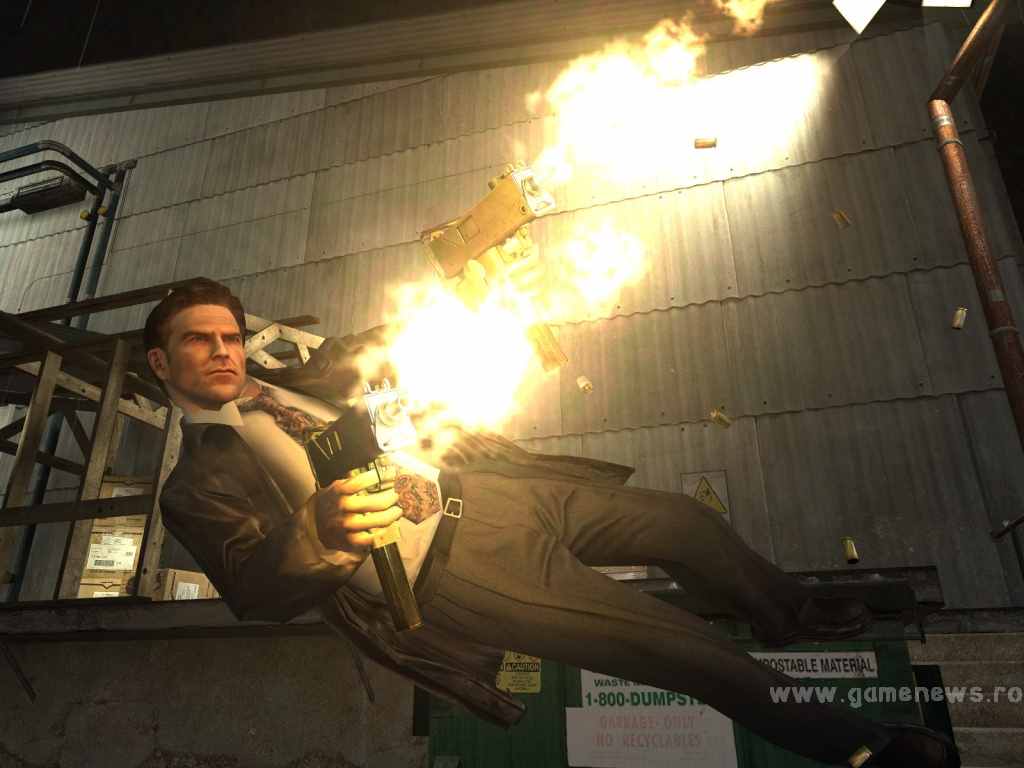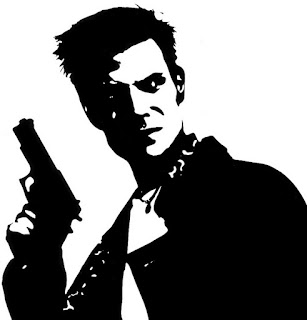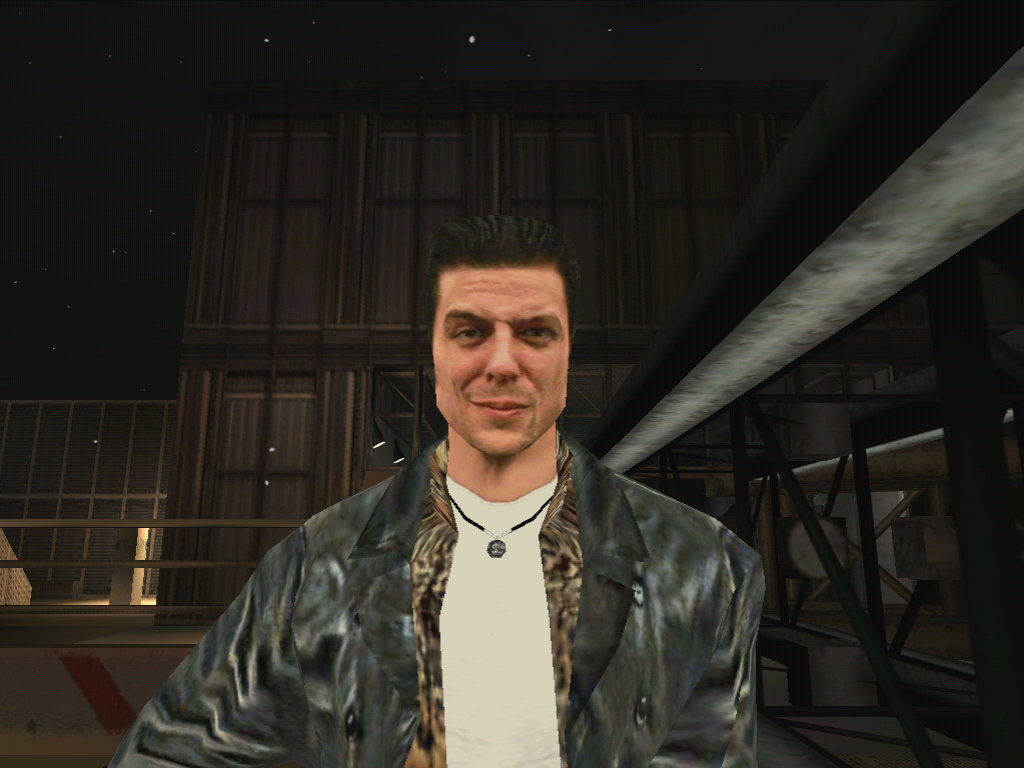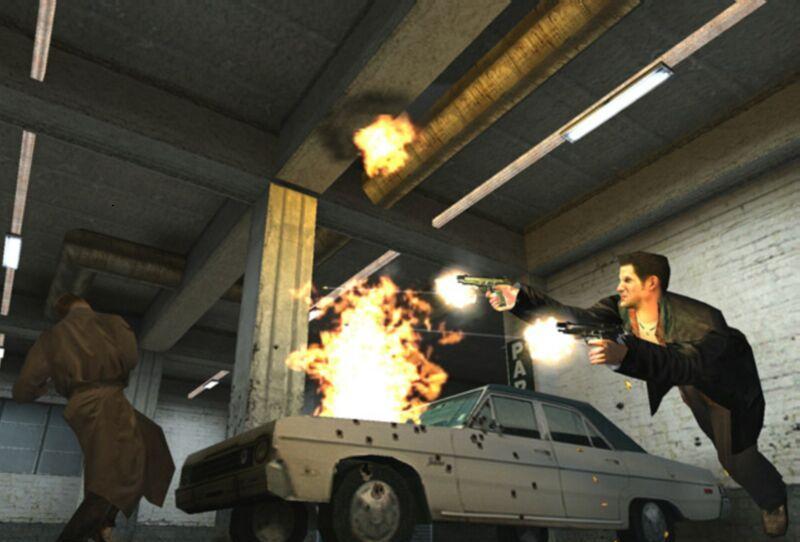Even at a young age, when all I was allowed to see of these
games was the artsy box art, I got a very…different vibe from Max Payne 2. A subtitle like “The Fall of Max Payne”
suggests something far more serious in tone, and looking at the art plastered on
the box, perhaps even more…sophisticated.
 |
| Bears vague resemblance to the cover of a My Chemical Romance album. |
.jpg) |
| No, excuse me, four. Idiots. |
But hey, everything worked out in the end. I got Kingdom
Hearts II and now here I am seven years later, graphically dissecting Max Payne
2 as if it’s some disgusting alien creature that just crash landed into a
scientific laboratory for which I am the only personnel. So, Payne 1 is a
decent game, awesome for its time. Does the first of two sequels do its part to
provide an improved gaming experience?
Oh, yes. Oh, yes, it
most certainly does.
From the moment I started the game, I could already tell
Remedy had really done their homework
since the first outing. Presentation on this one is excellent. I mean, on a
visual level, you still have to remember that it’s an “old game” to fully
appreciate it, but the technical improvements go quite a long way. It may be
shallow to say this, but Payne 1’s noir-inspired art design was kind of hard
for me to appreciate when everything looked so…hideous. In Payne 2, this was
not the case – in fact, despite a handful of blurry textures rearing their ugly
heads every now and then, I found myself seriously enjoying the game’s
aesthetic. The environments you see here are also a lot more visually varied
than what was seen in the first game. The snowy city districts, seedy buildings
and government laboratories can only go on for so long before I start to get a
bit tired of what I’m looking at. Here, we also get some disturbing mobster
funhouses, dingy and cheap apartment buildings, creepy hospitals, and a handful
of decent set pieces to go along with them. Smoother character animation also
leads to a few more in-engine cutscenes every now and then, and in two short
years, the characters have evolved actual faces
rather than jumbled masses of painted polygons.
 |
| 2003 |
Other nice visual flourishes include the screen changing to
sepia tone when slowing down time and more cinematic camera angles for the
Bullet Time move, making pulling off those stylish shoot-dodges that much more
fun and satisfying. Also, reloading
while slowing down time makes you do this really cool spinning thing, which
sometimes gives you a cinematic camera, too, if you’re being awesome enough. I
enjoyed that. Sound design in Payne 2 is also much more polished and realistic than the first game and also makes
greater use of music to enhance the atmosphere. The potential interaction with
the smaller elements in the environment, which is something that was already found impressive about the first game at the time, also
feels a bit more expanded and realistic. It’s certainly not on the level of
environmental interaction you’d see in such a game today and it’s a little
thing besides, but it’s just one more element that went toward making Payne 2 a
more immersive experience.
Max Payne 2 still makes use of comic book cinematics with
digitally colored live-action photographs for all of its major scenes. I
enjoyed these in the original game, but I couldn’t help but feel like some of
them looked more than a little awkward. Payne 2 even fixes this. On top of the prettier, more stylized coloring, the actions
and facial expressions are a lot more
believable and free of those mind-boggling “Wait, what?” moments peppered
throughout Payne 1’s story. And speaking of the story, ho-ly crap, is it good.
Whereas the first Payne’s story was a semi-cheesy but
nonetheless somewhat elaborate revenge story, Payne 2 is exactly what it says
on the cover: a film noir love story, and it is quite the film noir love story. Naturally, it’s a lot more
character-driven than Payne 1, going far deeper into the relationships of the
characters and the kinds of situations those relationships land our main
character in. It paints each one in a much more complicated light, none more so
than Payne himself. Not only that, but it goes into a bit more detail on the
secret organization introduced in the first game called the Inner Circle, and
how the events transpiring within affect those with connections to the group.
In my review of the first game, I called its story “complex”, but this deals
with some much more serious stuff. The first game had a few twists and
revelations, but the ones here feel a lot bigger and a lot more game-changing.
Of course, a more serious storyline is going to need some
more serious voice acting, and an improvement in the writing department would
be pretty appreciated, too. Believe me, Payne 2 delivers here as well. All of
the actors reprise their roles, but…they just do a much better job. James McCaffrey’s performance as the main
character especially stood out – what was once the voice of a stereotypical
hard-boiled cop has become something far more believable, far more human, and that’s pretty necessary,
since Payne is the story’s main focus. But perhaps this significant improvement
in acting quality owes less to the improved skill of the actors and more to the
improvement of the script. Payne 2’s script effectively pulls off what I can’t help
but think Payne 1’s was trying to do with its confused metaphors and ham-fisted
“fauxetry” – it brings me into Max Payne’s mind and helps me to get invested in
his story arc. In the first game, I grew somewhat attached to the character
based less on how much I actually liked him and more on how endearingly strange
he seemed to me based on the ridiculous stuff that kept coming out of his
mouth. In this game, I really liked
the guy and I even felt pretty sorry for him at a lot of times. The script has
some hammy moments, believe me, it does – “I wanted to reach inside my skull
and scrape out the pain” was one *ahem* memorable line, but for the most part,
it’s pretty freaking good. More often than not, when I found myself laughing at
something that was said, it was because it was actually funny. Yeah, don’t worry; Payne 2 may take itself more
seriously than the first, but it’s not at all pretentious.
Now, how has the gameplay evolved since Payne 1? Well, it
hasn’t really changed fundamentally, but the various tweaks that have been made go a long way in
improving the experience. One somewhat
minor, yet nonetheless noteworthy change is that doing a Bullet Time dodge
doesn’t decrease the hourglass meter anymore, basically allowing you to use it
as much as you want. At the same time, it’s become less of a dodge roll and
more of a dive. Using it will leave you lying on the ground until you pick
yourself back up, leaving you vulnerable and defenseless for several precious
seconds. It’s more empowering without being broken! I approve.
One of the biggest and most important evolutions in Max Payne 2 is
the more polished controls. One of my problems with Max Payne was that the
controls felt too oversensitive, which made any sort of precise aiming very
nearly an impossibility. Max Payne 2 feels so
much better by comparison. Aiming is for the most part silky smooth, the sniper
rifle actually works, and the game
just feels a lot better to play. Aside from that, the game design is just
generally better. Enemies are encountered in a much wider variety of
environmental situations than what were essentially narrow corridors, boxed
rooms and wide open spaces in Max Payne. Level design also feels a bit more
meticulous, providing more cover spots for you and your enemies, making each confrontation a bit more interesting
as well as getting rid of those occasional cheap moments the first game had.
Those frustrating moments of confusing “where do I go, what do I do” game
design are also (mostly) gone, too. The gameplay also capitalizes on the love
story aspect by switching control to the leading lady at certain points and
even having a segment where you provide Max with cover from above, thus
skillfully tying gameplay and narrative together – much better than the
original Payne did with its stupid nightmare sequences, at least.
Actually…the game still
has the playable nightmare sequences that annoyed me oh so much the first time
around. I can see what they were
going for with them: they wanted to draw us deeper into Max Payne’s tortured
psyche, make us feel more connected to the character. Unfortunately, they chose
to go about that by shoving in a clunky and forced gameplay change. However, in
Max Payne 2, they’re actually what they should
have been in the first place: simple, straightforward and not chock-full of awkward and out-of-place game mechanics. Not only
that, but I actually found some of them genuinely unsettling rather than so
over-the-top as to be ridiculous, and like the greatly improved writing, they really
did help me to feel more connected to
Max Payne.
Really, if there’s one complaint I have with The Fall of Max
Payne, it’s that it’s…really just too short. I mean, Max Payne wasn’t really
the longest game out there, but it
lasted at least about fifteen hours. This is more like ten, and while action
games don’t really need to be that
long, this game kind of left me wanting more. But maybe that speaks less for
how short the experience was and more for how sweet. Max Payne 2: The Fall of
Max Payne is an outstanding game
while it lasts. Every little tweak and improvement does its part to make this a
more polished, more thoughtful, more involving, more fun experience than the first game in every way. I still say that Alan Wake is currently Remedy’s
masterpiece, but if it weren’t for the short length, Payne 2 really wouldn’t be
that far behind.
And now, Remedy Entertainment is working on a new game
called Quantum Break. Not much has been shown, but judging by the trailer, it
looks like it’s going to be something big.
They say they’re using everything they learned from making both the Max Payne
series and Wake, and I’m definitely
interested in it, whatever it is. But yeah, that was Max Payne 2. Pretty fantastic game. But
it was actually the last game in the series for almost ten years, until
Rockstar Games developed the sequel themselves and finally released it last
year. Were they able to recapture what made the first two games so cool without
the help of Remedy? We’ll find out next time.

















